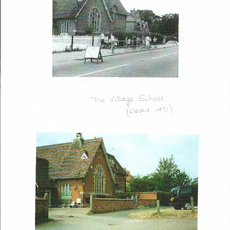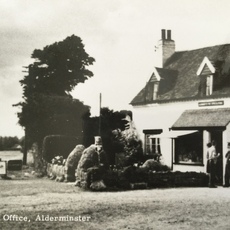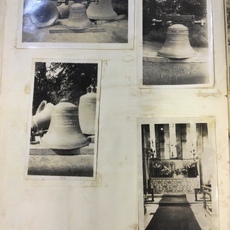
Welcome to the Alderminster History Group website. The site has been set up to try and tell the story of Alderminster using historical records, photographs and personal memories. It offers the opportunity for individuals to offer anecdotes of people, places and events.
Alderminster was listed in the Domesday Book as belonging to the Parish of Pershore. The Church of St Mary of Holy Cross was originally built in the Medieval period but was largely restored during the Imperial period. The earliest building on the site appears to have been erected early in the 12th Century.
NEWS
The next meeting will be at 10.30am on Wednesday 17th July 2024 at Alderminster Village Hall which is open to everyone
History Talk
There is a proposed talk about the Stratford upon Avon to Moreton tramway by Robert Howe scheduled at 7.30pm on Tuesday 24th September 2024 at Alderminster Village Hall. For more details please contact us at info@alderminster.org.uk
Open day Saturday 16th March 2024
Alderminster History Group held a successful open day at Alderminster Village Hall on Saturday 16th March 2024. It was open from 10.00am until 4.00pm with tea and cakes sold all day. The event was very well attended with an estmation of over 70 people, some of whose comments are shown below.

Comments from the recent Open Day
“Very, very interesting, are you doing another one? Please do.”
“Brilliant collection, very enjoyable”
“Absolutely excellent! Fascinating insights, I’ve learned so much – Thank you”
“Really interesting, great to see photographs and articles”
“I found it absolutely fascinating and thought it was very well put together. Exceeded my expectations”
“A great idea. What a lot of resources”
“Having lived in the village most of my life it’s interesting to learn new things. Needs days to read everything. Well done to everyone involved.”
“So interesting, well done History Group. Thank you”
“Thank you to all those who made this possible. Great stuff!”
Many thanks to those who attended, organised and helped make this a success.

If you are interested in joining Alderminster History group, either to research the history of your own home or to find more about the village, or if you want to help 'behind the scenes' by working on the website, please contact us using the emails below.
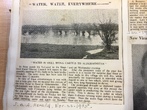
Alderminster History Group are always looking for more content, which includes pictures, historical documents and personal memories. Please get in touch if you can help.
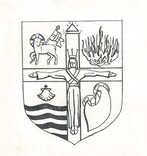
Alderminster History Group would like to thank the help it has received from other local groups including the Warwicksire History Society, Tysoe Heritage Research Group and Alcester and District Local History Society. It would also like to thank the Alderminster Parish Council and the Village Hall committee for their help and support.
THE HISTORY OF ALDERMINSTER
One old history of Alderminster has been located and was written by the Girl Guides under the leadership of Mrs Doreen Hutchings. This is an extract from that document.
Early History
AELDREHAME
Somewhere about a mile north of the Church was the township of AELDREHAME, as the Britons called it (i.e. the old town) but called by the HWICCANS(pronounced "Wichans") HWICCAWUDU. It had its Parish Church, and according to the Venerable Bede also a hermit, Saint Aegis, who lived there from 520 to 582. The first recorded Priest at AELDREHAME is Oegwgm in 469.
THE MINISTER
The District by the river to the south of AELDREHAME was originally called STURE probably after the River Stour.
Saint Kyneburgha, Abbess of Caistor, came here on her way to Wessex in 530, and it is probable that she influenced Saint Aegis to encourage the founding of a community at Sture for there is a record of there being a Church at AELDREHAME and a Convent at AELDRED - STUREMINSTER in 549 (i.e. the Minster of AELDEHAME at Sture). The founding of this Minster Church, then, probably dates from this period of the 6th Century.
Saint Aegis died in 582 (592 according to Aerich of Sherbourne) and was buried in the Minster Church where his Shrine almost immediately became a centre of pilgrimage for princes and peasants alike. However, with the reorganisation of the Church in England under Saint Theodore of Tarsus, Archbishop of Canterbury, St. Aegis' Shrine was removed, though his body doubtless remained in the Church (673 A.D.) and his name was retained in the calendar under 15th May.
By 843 the area around AELDREDSTUREMINSTER seems to have become fairly populous and the Chaplain of the Convent was appointed Parish Priest, and the Minster Church became also the Parish Church whilst the Church at AELDREHAME was reduced to the status of a "Chapel of ease."
In 960 the Minster was taken over by MALMESBURY ABBEY as a daughter house, but after the Norman Conquest in 1066 the Normans seem to have followed their usual practise of demolishing the old Saxon Church and erecting what they considered to be a more worthy building on the same site. The present Nave is part of the Norman Church.
In 1193 the Minster became a Priory of PERSHORE ABBEY and the Norman chancel was demolished to make way for the tower, transepts and the new chancel, which were consecrated by the Bishop of Worcester on 14th July, 1286. Thus, the Church became in effect two Churches, the conventual or monastic Church of the Holy Cross consisting of the Name with the High Altar under the tower.
THE END OF AELDREHAME
In 1348 the Black Death struck and Aeldrehame was sealed off from the rest. The Prior of Aeldrehame and Abbot of Stourminster, Prior Aelfric IIIm was one of the early victims and in 1349 the survivors settled down around the Minster Church to form the present village and Aeldrehame was abandoned and probably burnt.
In the 15th Century a Chapel of the Holy Cross was erected to the north of the Chancel.
In 1550, without the authority of either convocation or Parliament, the Protestant Regency Council pillaged the Church, removed the Altars, and white washed the beautiful painted walls. In 1935 one Altar was found beneath the Chancel floor where it had been buried to save it from desecration and this is now in use in the North Transept.
The font which is now in the porch is the one which was placed in the Church after the restoration of the Church to her Churches after 1660
THE NAME
The district is about a mile to the south of Aeldrehame and was originally known as Sture, probably after the river Stour.
By the 12th century, the Minster had given name to the district, as the name had been corrupted to Aldermanneston.
Further corruptions of the 13th Century are ALDERMONESTON, ALDERMAISTON, ALDERMONISTON AND ALDERMYNSTRE. It will be remembered that the name Aeldreham means old times so we see the name Minster which is corrupted to "old Monastry" or "old Minster".
From 16th - 19th Centuries the village seems to have been known Alderminster which is the corruption of ALDERMANWESTON. In modern times the name Alderminster (Aeldrehame's Minster or Old Minster) has become general.
Alderminster School
Alderminster School was built in 1871, paid for solely by James Robert West of Alscot Estate to educate children from the local area. The building had a large classroom which was divided into two for infants and juniors. The earliest record of the school in the 1881 census shows that the headmistress was a Miss Emma Bason. Other members of staff who have taught at the school over the years include. Mr. Bates (headmaster),Mrs. Ceretha Randle (headmistress), Mrs. Noyce and Mrs. Meggs (infant teachers), Mr. Hibbard and Miss Chandler.
Looking back at School Log books dating from 1906 -1960’s it seems that the school was regularly visited by a School Attendance Officer. Pupil numbers varied over the time but classes grew during the war years when several evacuees came to the village. A few boys were sent over from Coventry after the city was heavily bombed in November 1940. Local boys had to stay at home to work on the family farm while the men were away fighting.
The children had regular visits from the dentist and a nurse who would “check their heads!” Scarlet fever was around in the 1920’s/30’s and one entry tells of a school library book that had to be destroyed because it had been handled by a boy who contracted the disease.
Several national events were logged including the death of King George V in 1935 when the children were given the afternoon off on the day of his funeral. Captain Green also came to the school many times to check the gas masks after WW2 broke out in 1939.
On a lighter note, the children all seemed to have a happy time at Alderminster School, enjoying wild flower walks up Loxley Lane (New Road) and “games” afternoons with the local policeman in Whitchurch farm meadow, playing football in winter and cricket in summer. Playground games included hopscotch, tig, cowboys and Indians, marbles, conkers and skipping. Many of the children who lived in the village went home for lunch, whilst others remember hot dinners being delivered in stainless steel containers. A Nativity was always performed at Christmas and the children regularly attended church. Many also joined the Girl Guides and Boy Scouts groups which were held in the village.
Sadly, due to dwindling numbers, the school closed in 1971, after 100 years! Following this many village children attended nearby Ettington School.
More information will be posted in the memories section and Alderminster History Group is compiling a list of former pupils, for more details or to add more names please contact us.

The Church Bells
In 1938 the five bells from St. Mary and the Holy Cross Church in Alderminster were sent to The John Taylor Bell Foundry in Loughborough to be restored and retuned at a cost of nearly £200. The bells were returned during the summer of the following year together with a sixth bell, paid for by an anonymous donation. The inscription on the new treble bell, which weighs 5cwt, read “A thank-offering for peace, Christmas 1938. Venite adoremus D.G.” The work of rehanging, installing new fittings and reinforcing the wooden bell frame was nearly complete.
The bells were dedicated at a special ceremony by the Bishop of Coventry (Dr. Mervyn Haigh) on Wednesday June 7th 1939.
By May of 1939 only £140 towards the cost had been raised so the vicar, The Rev. Frank Thornhill, took the opportunity to “appeal most earnestly to every parishioner to come forward and to do his or her share in paying off this remaining debt”.
It had been decided to hold a Gift Day on June 10th and the vicar would be in church all day to “receive gifts of money, great or small”. It was decided that to organise and run a fete or pageant would mean a great deal of work and anxiety for everyone concerned, as well as a financial outlay with perhaps an exceedingly small return if the weather should happen to be wet. So he suggested villagers should come along and donate what they would have spent if a fete had been held. “If you can spare more, we shall be all the more pleased. Remember, you are doing this for the bells of your own Church”.
Nearly everyone in the parish came to present their gifts on this day and £50 15s, 7d was raised. Rev. Thornhill wrote “I am most deeply grateful to you all for your great generosity, but I am still more thankful for the spirit in which you came, because it proved to me that so many of you have a real love for your Parish Church and are anxious to take you share in it’s upkeep and repair. I thank you one and all for your splendid response.”
(Source: articles in the Stratford Herald 1939)
MEMORIES
Listen to the memories of former resident William Lockwood
These are William's own words and own memories, no responsibility is accepted for their accuracy.
Just click the link and on the soundcloud site please click the play button. You can pause, stop, etc at any time.
Memories of School Days
"Some Wednesday afternoons P.C Gibson, the village policeman took us to play football in Whitchurch Farm meadow.
I went home to grandmother’s for lunch."
Jimmy Meadows
As a school we always went to church on Maundy Thursday. Every Christmas we had a party after school. Summer term we had a day visit, for example to Dudley Zoo or Weston-Super Mare!
Rita Lewis (Rumble)
I enjoyed most lessons but was not keen on arithmetic! We had nativity plays at Christmas, I usually had a lead role as I had a good singing voice. We went country dancing at the Village Hall with Mrs. Randle.
Mrs. Randle taught us to knit. I remember knitting a pair of yellow mittens!
David Simms
I remember the Queen’s Coronation. We were loaned a television from Mr. Thorp for anybody to watch if they wanted to.
Ron Bruce-Moore
We drank a small bottle of milk every day and had an afternoon nap in the infants .Mrs Randle read a chapter of a book the last half hour of the day. That’s where my love of a good book came from. I disliked spelling tests and times tables!
Kate Wood (Lea)


